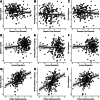Testing locus coeruleus-norepinephrine accounts of working memory, attention control, and fluid intelligence
- PMID: 37081225
- PMCID: PMC10118234
- DOI: 10.3758/s13415-023-01096-2
Testing locus coeruleus-norepinephrine accounts of working memory, attention control, and fluid intelligence
Abstract
The current set of studies examined the relationship among working memory capacity, attention control, fluid intelligence, and pupillary correlates of tonic arousal regulation and phasic responsiveness in a combined sample of more than 1,000 participants in two different age ranges (young adults and adolescents). Each study was designed to test predictions made by two recent theories regarding the role of the locus coeruleus-norepinephrine (LC-NE) system in determining individual differences in cognitive ability. The first theory, proposed by Unsworth and Robison (2017a), posits two important individual differences: the moment-to-moment regulation of tonic arousal, and the phasic responsiveness of the system to goal-relevant stimuli. The second theory, proposed by Tsukahara and Engle (2021a), argues that people with higher cognitive abilities have greater functional connectivity between the LC-NE system and cortical networks at rest. These two theories are not mutually exclusive, but they make different predictions. Overall, we found no evidence consistent with a resting-state theory. However, phasic responsiveness was consistently correlated with working memory capacity, attention control, and fluid intelligence, supporting a prediction made by Unsworth and Robison (2017a). Tonic arousal regulation was not correlated with working memory or fluid intelligence and was inconsistently correlated with attention control, which offers only partial support for Unsworth and Robison's (2017a) second prediction.
Keywords: Arousal; Attention; Intelligence; Pupillometry; Working memory.
© 2023. The Psychonomic Society, Inc.
Figures










References
-
- Alnæs, D., Sneve, M. H., Espeseth, T., Endestad, T., van de Pavert, S. H. P., & Laeng, B. (2014). Pupil size signals mental effort deployed during multiple object tracking and predicts brain activity in the dorsal attention network and the locus coeruleus. Journal of Vision, 14(4). 10.1167/14.4.1 - PubMed
-
- Aminihajibashi, S., Hagen, T., Andreassen, O. A., Laeng, B., & Espeseth, T. (2020a). The effects of cognitive abilities and task demands on tonic and phasic pupil sizes. Biological Psychology, 107945. 10.1016/j.biopsycho.2020.107945 - PubMed
-
- Aminihajibashi, S., Hagen, T., Laeng, B., & Espeseth, T. (2020b). Pupillary and behavioral markers of alerting and orienting: An individual difference approach. Brain and Cognition, 143. - PubMed
-
- Aminihajibashi S, Hagen T, Foldal MD, Laeng B, Espeseth T. Individual differences in resting-state pupil size: Evidence for association between working memory capacity and pupil size variability. International Journal of Psychophysiology. 2019;140:1–7. doi: 10.1016/j.ijpsycho.2019.03.007. - DOI - PubMed
Publication types
MeSH terms
Substances
LinkOut - more resources
Full Text Sources

